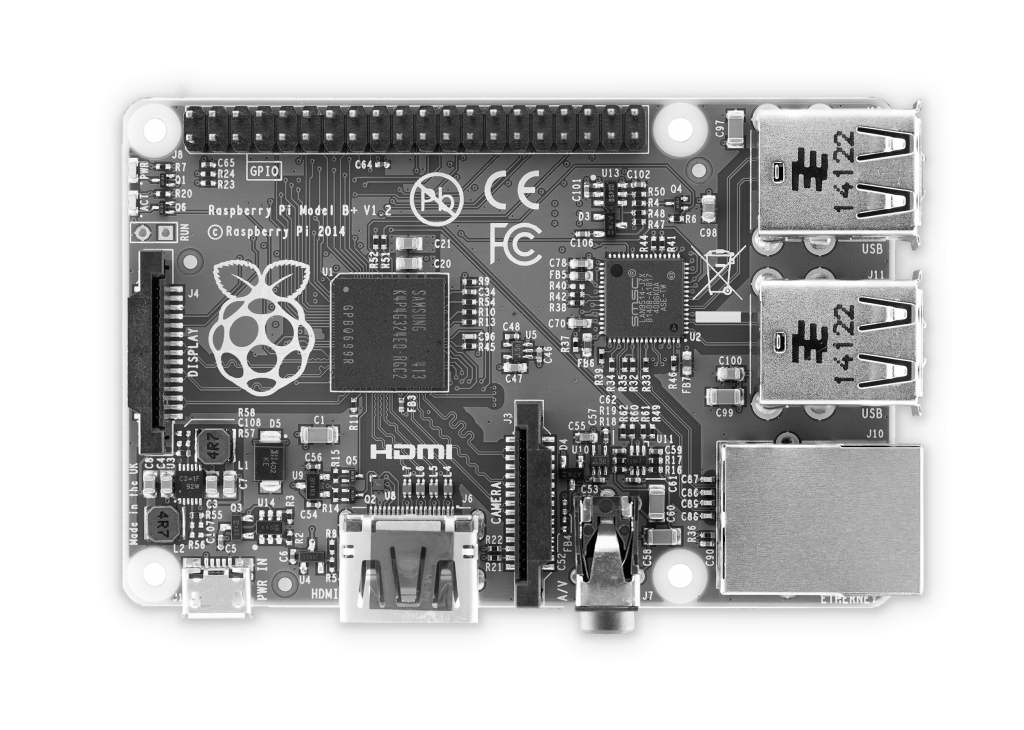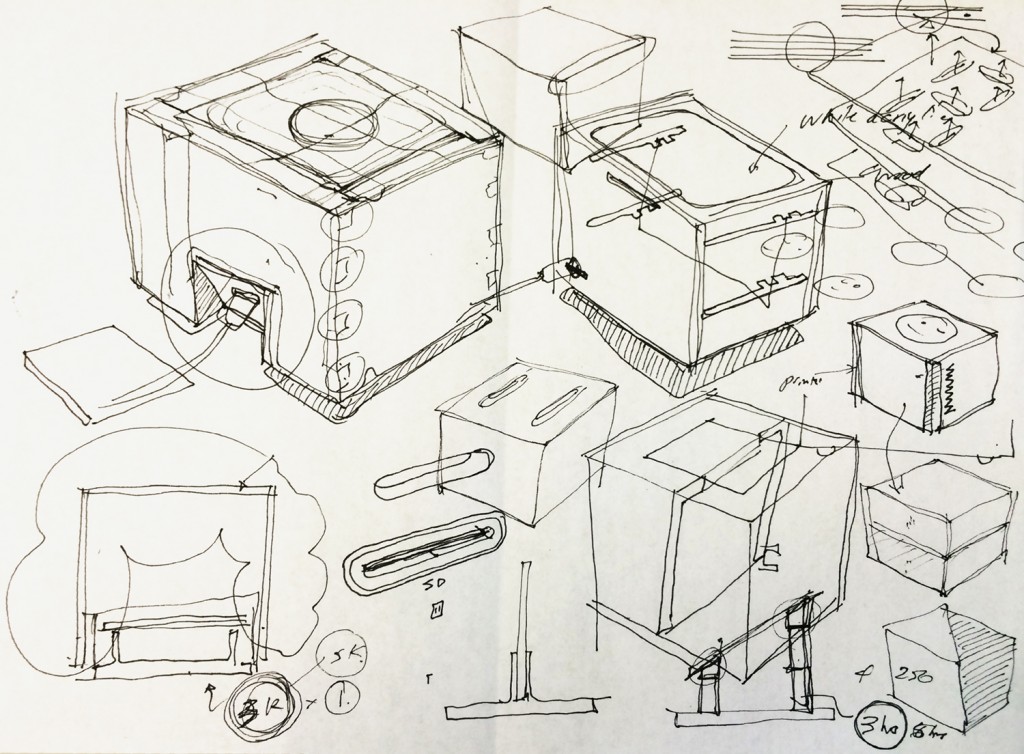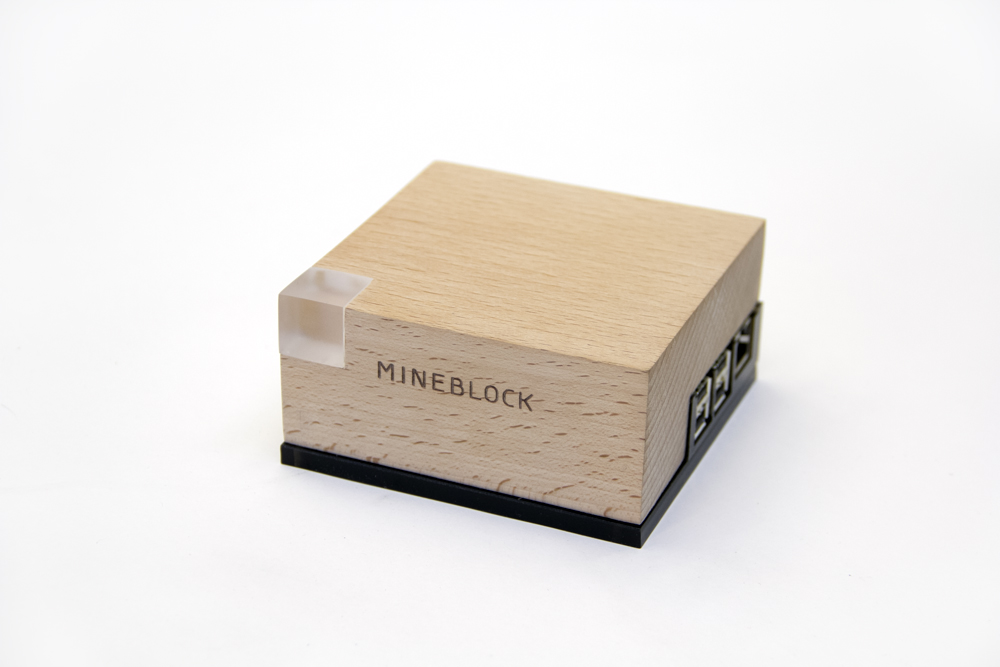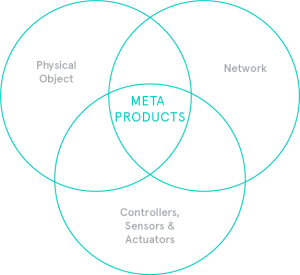While pursuing a Master in Digital Media last year I was given the opportunity to explore a number of emerging design spaces. As a designer I have observed that over the past 25 years, design as a discipline has constantly been in flux. Designers are always adapting to change, learning about new possibilities and upgrading skills to consider the rapid changes in technology, business and culture. This article identifies a nascent area of design called Meta Products that occurs when software and hardware design are merged to create products that provide a network as their primary value offering.
The Meta Product is an emerging design space that represents a subset of the Internet of Things (IoT) or smart objects that are driven by human-centred practice more than technological innovation. This article describes the research, process and challenges of creating my thesis project—Mineblock—and how it represents a Meta Product. The article is structured into three sections; the first section, “Designer Meets Maker” is about the recent factors that contribute to the abrupt and disruptive growth of Meta Products. The second section, “Creating Mineblock” is about the process and challenges of the Mineblock project and of Meta Products in general, as well as the methodologies and design principles required for their creation. The final section “Designer-led Startups” outlines the challenges of languages and proficiency for designers to effectively produce Meta Products within contemporary agile or lean software development methods and provides suggestions for how designers can integrate into the culture of technology startups.
It’s true that the idea of digital features in product design is not entirely a new concept. Digital inputs like sensors, cameras & buttons and outputs like screens & sound have clearly inundated the traditional product design arena for decades now. Yet Meta Products give us a fundamentally different approach. Consider flipping the traditional model over: instead of the physical product being the main value proposition, Meta Products are created with the network or software providing the primary value and the physical product attributes acting as a vessel to convey, contain or carry the digital service.
In this article I’ll discuss not only the mashup of digital and physical design but the integration of best practices from interaction design, industrial design and startup methodologies to create cohesive product offerings.
Designer Meets Maker
It comes as no surprise that Maker culture is tipping into mainstream. What was once the Do-it-Yourself (DIY) and Craft movements have now evolved to include open source culture, web technology, electronics and a pinch of hipster nostalgia. In 2013, there were 100 Maker Faires around the world including its two flagship events in the Bay Area and New York and 93 mini-faires worldwide [1]. In the United States alone, there are reportedly approximately 135 million adult Makers — that’s well over half (57%) of the American population ages 18 and up [1]. You only have to visit a Maker Faire to see that people are creating amazing projects in their basements and garages all over the world.
People are mashing up low-tech and high tech in amazing ways, combining electronics and 3D printing and sharing how they built their creations on sites like Instructables.com. For example, Matt Brailsford took the open source music streaming software called Pi MusicBox, combined it with Near Field Communication (NFC) hardware, hacked apart an old cassette player to create a beautifully nostalgic music experience that streams Spofify’s cloud music service [13].
Not only is the amount of exploration in the Maker world impressive but, more importantly, the sharing of these ideas and instructions are key to its vibrancy. To summarize the Maker phenomena is a result of the following core tenets:
1. Software to create and prototype ideas
2. Open hardware and cloud technologies
3. A cultural norm to share concepts and instructions
As amazing as the Maker movement is, the majority of the projects are driven by technology, gadgetry and an ethos that “you build it because you can”. Making for the sake of making is what creates a culture of experimentation, the “tinkerer” attitude helps frame learning electronics in a more accessible and less serious way yet at some point we need to shift to a more critical lens. It will serve us well to apply tried-and-tested human-centred design methodologies to the Maker space, understanding what we’re creating, who it’s for and why. By properly understanding what we’re going to build and our intended user experience (UX), our experiments and products will end up being far more engaging.
As designers, we are compelled to explore and learn about the psychological mindset, the expectations and context of the intended people that we design for. It is with this human-centred iterative design approach that our explorations will achieve truly meaningful and useful experiences. Ethically we are also motivated to use design as a tool of critical inquiry to discover not only what is possible with new technology but what is preferable and sustainable from economical, ecological and cultural perspectives. As we move towards a world inundated with electronics, smart gadgets and refrigerators talking to your milk, it is our responsibility to question the momentum gathered by Internet of Things (IoT) hype, as it is primarily driven by technology, commercialization and not enough by human-centred design principles.

The electronic circuit boards, transistors, capacitors and rectifiers once developed for electrical engineers have continued to evolve into accessible physical and digital prototyping kits due to the sharing of vibrant open source communities. Take for instance the story of the Arduino, a $35 electronic prototyping tool introduced in 2005, now with 1.2 million boards out in circulation, and has been adopted by makers, artists, and product designers in companies and educational institutions all around the world.
Secondly, there’s MIT’s amazing Processing software environment, an open source visual computational platform that has become the de facto digital tool for creating screen-based digital art and design prototypes.

Thirdly, there is the brilliant Raspberry Pi (RPi), a tiny $35 prototyping computer that runs the open source Linux operating system [11]. RPi is a flexible platform that can be easily expanded with sensors and actuators like the Arduino but with a fully functioning operating system. Raspberry Pi is growing quickly in popularity and has sold over 4 million in 2014. The level of experimentation and product refinement have taken a considerable jump with the RaspberryPi which are evident in projects like BBC’s RadioDan, Kano and my own Mineblock project.
Designers now have the chance to engage with makers, developers and business innovators to help them create meaningful products and services that consider long-term implications and add to the quality of our lives. That is how I came to work with engineers, product designers, and business mentors to build Mineblock.
Creating Mineblock
As described earlier, the Maker movement provides a new opportunity to create objects that combine digital and physical characteristics. In the past year my thesis project has explored the harmonious merging of hardware and software to create the Mineblock product. At an early stage of the development it became clear through design research that a great percentage of parents of “Minecraft”-playing children knows very little about the technology behind multiplayer games and by extension, how to create a multiplayer gaming environment for their home. Secondly, these parents would rather not have their children play on open public servers on the web or pay $30/month for dedicated “Minecraft” hosting services. These parents all preferred to have a physical tangible object that would provide the gaming environment.
The idea for Mineblock began when my 8-year-old son, Jivan, explained that a roller coaster he had built had been destroyed by a stranger in a multiplayer “Minecraft” game. Other parents found that this was a common occurrence, so I set out to solve the problem using the affordable prototyping board, Raspberry Pi [11]. By the end of my first semester in the MDM program I pitched a concept for helping parents give their children a place to play “Minecraft” safely—the idea of “security in a box” I came to call Mineblock [14]. With this in mind, I aimed to achieve three main goals for Mineblock, in order to create a minimum viable product (MVP):
- Run a “Minecraft” Server on the RPi
- Dynamically create an new ad-hoc network if there isn’t a network to connect to
- Create a web app that allows people to connect and setup their Mineblock to their home wifi

Knowing that being able to keep a close eye on all of these considerations simultaneously was going to be next to impossible, I asked a few friends to help with the product design aspect of the project. I partnered with Jason Miller, a recent graduate of the Emily Carr University Industrial Design program, and Afshin Mehin, who runs Woke Design in Vancouver. Both helped immensely in establishing the physical attributes of the project.
The physical prototyping was done in parallel with the software development and the two often informed each other. In retrospect, this parallel development, although difficult with a small team, was clearly the right way to go. Without the clear interplay between physical and digital characteristics, the product would not have ended up in a resolved state.
Iterations

From the beginning I was adamant that the product reflect “Minecraft’s” unique visual language in a subtle and understated way. Because the large lego-like perfect cubes were the elemental construction blocks of “Minecraft,” it seemed only fitting that the first prototype reference this Mineblock aesthetic. I was set on having the enclosure for Mineblock be wood but was unsure of the size, type and the construction. I believe that there’s an interesting tension or contrast between the digital nature and precision of the Raspberry Pi and the organic materiality of a wooden box.
The next prototype was a wooden box constructed of quarter-inch plywood glued together. This ended up feeling somewhat large both in your hand as well as in a backpack or handbag. It became immediately clear that Mineblock should not be a cube and would have to convey the cube motif in another way.
After about 5 different prototypes we settled on using a CNC machine to hollow out a block of Beech wood. This approach cost 6 minutes in time and the results were accurate and beautiful. Additionally, the machine operator assured us that a larger number of blocks could be hollowed out of one large plank and then cut. This would be an efficient way to produce a large production run. This approach was by far the most promising production technique.
Developing Identity Design

The brand identity component was an important aspect of the project from the beginning. How would the product exude a cube visual language? How would it refer to the distinctive “Minecraft” aesthetic in a subtle way? The initial logo had a simple isometrically—drawn cube in it, and the idea of bringing that cube into a 3D representation came about. We experimented with quite a few approaches before we decided on one. Here are some of the more successful ones:
- laser-cut cube
- shallow router indentation of cube
- cube cutout
- acrylic block glued into corner
Defining Meta Products
The Mineblock project represents a new type of object, a specific kind of smart object called a Meta Product whose primary value is the network that it provides.
As described in the book, Meta Products, the characteristics of a Meta Product are:
1. Physical Object – (location, physicality, ergonomics)
2. Controllers, Sensors & Actuators (inputs, outputs and processing)
3. Network (realtime data, social networks, mapping and APIs) [9]
To give you a better understanding of Meta Products, here are a few somewhat well-known examples. Withings is a company founded in 2008 that brings new functions to everyday objects through a connection to the internet. They have released a whole ecosystem of health and fitness products that wirelessly transmit data to the cloud and provide insights to its user.
It’s difficult to talk about the internet of things without mentioning the huge success of Nest. As Tony Fadell, CEO of Nest said “We don’t just see a thermostat with a better user interface; we see a smartphone that has thermostat functions. When you redefine the world that way, it opens it up to many more possibilities.”
Author of Smart Things, Mike Kuniavsky puts it well, “Situating the design of user experience within an ecology of spaces, devices, and audiences from small to large scales in interactions has never been more necessary” [6].
In 2014 I was given the opportunity to work with Recon Instruments as an industry partner with the MDM program to design a location-based application for the their newest product: Jet, a Heads-up Display for cyclists [12]. The experience was challenging and I realized that even a new company like Recon had unintentionally created artificial barriers between their engineering, business and design teams. The way that the creative process was compartmentalized led to many problems and lack of vision across the entire user experience. The resulting customer experience across the Jet’s heads-up display, mobile app and website was disjointed and incoherent. Even within the Jet design team, the software and the hardware/product design teams were distant, and learnings from one side barely ever informed the other. Based solely on a few informal conversations with others working in this hardware/software space, I found this to be a common issue and one that will require attention and new methods of creation.
Although we’re still in the early days for the evolution of Meta Products, there are a number of new design principles to consider. These principles do not replace the established principles of design but should be seen as new considerations. Designers should plan for integrating the various creative processes, aiming for a harmonious merging of hardware and software design. At the core of designing Meta Products is data, yet data is meaningless to people unless properly contextualized and synthesized into information that can inform and change the behaviour of the user. Data should be seen as a primary material in the design of this type of networked objects.
Design Principles for Meta Products
1. Integrated Process (Harmonious processes of software and hardware design)
2. Data as the raw material (how and when do we turn data into information?)
3. Design for Privacy (personal data is easily tracked and stored, what are the short and long term implications)
To further explore the topic of designing for privacy, see the 7 Foundational Principles of Privacy By Design by Ann Cavoukian [2]. These considerations are crucial when designing great Meta Products. There’s a great deal more to write about this subject and I have been working toward writing a book on designing Meta Products.
Designer-led Startups
While working on my thesis project last year I was constantly being asked to explain Mineblock’s value proposition and consider the possible revenue streams, resources and partnerships to make the project a reality. Fortunately I was able to respond accordingly mostly because I had experienced running my own design firm – Lift Studios [8]. But I realized that a large percentage of today’s designers do not have the same experience and have deficits in the areas of business entrepreneurship and technological proficiency. Designers considering moving into designing for Meta Products would clearly benefit from having a stronger understanding of the technology startup world, its’ fundamentals, process and terminology. How does one create a product strategy? Or a business model? How would your startup transition from prototype to delivering production units of your product? What is the role of a UX designer within a startup?
It’s not as though designers have a shortage of ideas to build companies from. Designers see the world filled with opportunities, possibilities are ample and the best are incredibly good at fluidly moving between divergent or generative to convergent or critical ways of thinking. I suspect that while not all, a large percentage of designers are well-positioned to create or become key members of startup ventures. Yet typically designers are taught or trained to work for others, become part of a design service, and their brilliant ideas confined by the constraints of the companies they work for. How can we introduce new career paths for designers?
Over the past few years, Vancouver has seen a bit of an explosion in the world of technology startups. The combination of a rapidly growing local talent pool and the efforts of incubators like Growlab (now Highline – http://www.highline.vc), Launch Academy and Invoke Labs have caused engineers and venture capitalists to flock to the city just as the tech giants, Amazon and Facebook, settle in [7, 5]. It’s all well and good but seems to be a missing link in the makeup of the average startup. Typically, tech startups have a technologist and a business or marketing – type person but they seldom include designers. Whether you’re in San Francisco, Toronto, New York or Vancouver this is quite often the case. Why is this so? Even when it has been identified that a key differentiator in the startup world is user experience. As Founder and CEO of Hootsuite, Ryan Holmes puts it “Among the only ways to stand out from the crowd is with an intuitive interface that users love and that lends itself to quick adoption” [4].
Design Proficiencies
Designers are taught to hone their design chops through discourse, creating a more and more sophisticated language around design. This would be fine if designers only communicated with other designers but what if they were required to pitch their concept to business or tech folks? Understandably, many if not most designers are ill-equipped to converse with the business and technology people that are instrumental in lifting a concept to the startup level.
For designers to be successful within startups they will have to be conversant in the terminology, structures and conventions used to describe business models and technologies.
Startup Language

In an attempt to introduce entrepreneurial thought into the design curriculum at Emily Carr University of Art + Design, I’ve experimented with teaching the Business Model Canvas to the last few cohorts of the Interaction Design Program. The Canvas, from the amazing Business Model Generation book always ends up being one of the students’ most memorable workshops allowing quick, playful collaborative iterations for conceiving unique sustainable business models [10].
When I was asked to generate a business model for the Mineblock project I had used the canvas so many times that it had become second nature. This is something we should always aim for: when the tools dissolve and you’re able to create with a fluidity that leads to the most promising results.
Technical Proficiencies
There’s a common joke in the UX industry that people that can code, design and understand business strategy are “unicorns.” That they are so rare that they may not actually exist. Yet over they years I seem to meet more and more people that would fit this description. Personally, I find that the more I understand the materiality of digital media the better my concepts and designs become. One feeds the other. Simply put, the act of making or the crafting of digital media should not be relegated to only programmers. When designers engage with the act of coding they learn about what is feasible, what is appropriate and how to communicate with programmers in meaningful ways. Designers that are against the idea of coding have either been taught that you just pass a Photoshop, or worse, InDesign file over to a coder and they’ll build it, or somewhere in their education they were wrongly told that creative people don’t need to know math and by extension, programming. At this point we know this is not true and there’s a huge community of artists and designers that code and share libraries and tools as mentioned in the first section of this article. Designers need to code not to become engineers but to be able to hold a conversation with engineers and volley ideas back and forth.
Lean UX
In the software development industry and conversely the tech startup world they have widely adopted agile development methodologies. Designers on the other hand are taught human-centred design methods; both are iterative but not in the same way. Designers tend to iterate on concepts and aesthetics or visual design; Agile engineers iterate on implementations and stick to the same concept. As you can probably guess, these approaches do not mesh. Jeff Gothelf saw this coming and wrote a book called Lean UX, which finds a balanced approach to integrating design into the Lean Startup methodology [3]. The approach centres around building a minimum viable product (MVP) and iterative cycles.
Transitioning into Production
Once you’ve built your prototype and been able to validate its concept with its target audience it’s time to scale up your startup. There are many ways to do this and most funding routes start with angel investment or seed funding. But with the advent of crowd-funding the first round of funding can come from popular sites like Kickstarter or Indiegogo. This is by no means easy money and there’s a great deal of work to do to launching and maintaining a crowd-funding campaign.
This article illustrates a number of important points about the evolution of design education. With the instantaneous growth of the Maker movement comes an opportunity for designers to move into design hybrid products that are equal part digital and physical. The tools for creating these products have become affordable and accessible to all to explore. The new canvas for designers creating Meta Products is both inspirational and comes with a new set of challenges. Now more than ever, designers must be thinking about privacy and how to create experiences that are thoughtful in regard to people’s personal information. And finally, designers must become equipped to conversing with people trained in different areas to be most effective within startup communities. New proficiencies are necessary in business and technology to best communicate with investors, co-founder and team members. The Mineblock project taught me a great deal about designing Meta Products. It behoves us to incorporate these new methods and approaches to Meta Products into our design curricula as we look ahead to teaching the new generation of designers.
References
- [1] Amtel Technologies. DIY by the numbers: Why the Maker Movement is here to stay, 2014. http://blog.atmel.com/2014/09/15/diy-by-the-numbers-why-the-maker-movement-is-here-to-stay.
- [2] Cavoukian, A. Privacy by design: The 7 foundational principles. Information and Privacy Commissioner of Ontario, 2011. https://www.ipc.on.ca/images/resources/7foundationalprinciples.pdf.
- [3] Gothelf, J. Lean UX. O’Reilly Media, 2013. http://shop.oreilly.com/product/0636920021827.do.
- [4] Holmes, R. Ryan Holmes: Design First, Engineer Later. The Wall Street Journals, 2014. http://blogs.wsj.com/accelerators/2014/02/19/ryan-holmes-design-first-engineer-later.
- [5] Invoke Media | Digital Agency | Vancouver, 2002. http://www.invokemedia.com.
- [6] Kuniavsky, M. Smart Things: Ubiquitous Computing User Experience Design, 2010. https://www.elsevier.com/books/smart-things-ubiquitous-computing-user-experience-design/kuniavsky/978-0-12-374899-7.
- [7] Launch Academy, 2012. http://www.launchacademy.ca.
- [8] LiFT Studios – an Interaction Design Agency in Vancouver, 2004. http://www.liftstudios.ca.
- [9] Meta Products, 2011. http://www.metaproducts.nl/book.
- [10] Osterwalder, A. and Pigneur, Y. Business Model Generation, http://www.businessmodelgeneration.com/book.
- [11] Raspberry Pi, 2009. http://www.raspberrypi.org.
- [12] Recon Instruments. Recon jet: The first heads up display for sports, 2007. http://www.reconinstruments.com/products/jet/.
- [13] Swift, M. Kick It Old School With This Spotify Cassette Recorder. Brit + Co., 2014. http://www.brit.co/spotify-cassette-recorder.
- [14] The Centre for Digital Media, 2012. http://thecdm.ca.


